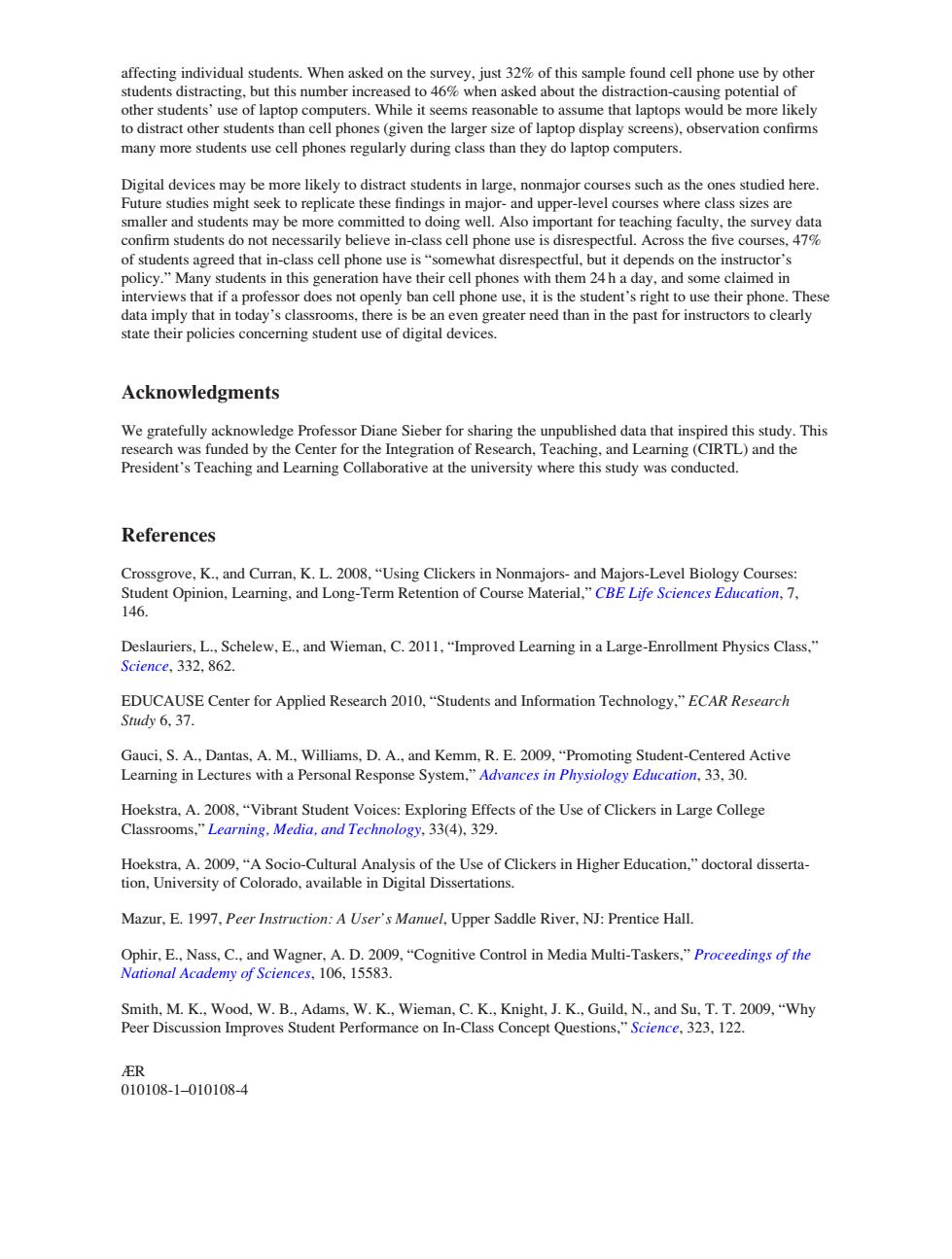正在加载图片...

affecting individual students.When asked on the survey,just 32%of this sample found cell phone use by other students distracting,but this number increased to 46%when asked about the distraction-causing potential of other students'use of laptop computers.While it seems reasonable to assume that laptops would be more likely to distract other students than cell phones(given the larger size of laptop display screens),observation confirms many more students use cell phones regularly during class than they do laptop computers. Digital devices may be more likely to distract students in large,nonmajor courses such as the ones studied here. Future studies might seek to replicate these findings in major-and upper-level courses where class sizes are smaller and students may be more committed to doing well.Also important for teaching faculty,the survey data confirm students do not necessarily believe in-class cell phone use is disrespectful.Across the five courses,47% of students agreed that in-class cell phone use is"somewhat disrespectful,but it depends on the instructor's policy."Many students in this generation have their cell phones with them 24h a day,and some claimed in interviews that if a professor does not openly ban cell phone use,it is the student's right to use their phone.These data imply that in today's classrooms,there is be an even greater need than in the past for instructors to clearly state their policies concerning student use of digital devices. Acknowledgments We gratefully acknowledge Professor Diane Sieber for sharing the unpublished data that inspired this study.This research was funded by the Center for the Integration of Research,Teaching,and Learning(CIRTL)and the President's Teaching and Learning Collaborative at the university where this study was conducted. References Crossgrove,K.,and Curran,K.L.2008,"Using Clickers in Nonmajors-and Majors-Level Biology Courses: Student Opinion,Learning,and Long-Term Retention of Course Material,"CBE Life Sciences Education,7, 146. Deslauriers,L.,Schelew,E.,and Wieman,C.2011,"Improved Learning in a Large-Enrollment Physics Class," Science,332,862. EDUCAUSE Center for Applied Research 2010,"Students and Information Technology,"ECAR Research Study 6,37. Gauci,S.A.,Dantas,A.M.,Williams,D.A.,and Kemm,R.E.2009,"Promoting Student-Centered Active Learning in Lectures with a Personal Response System,"Advances in Physiology Education,33,30. Hoekstra,A.2008."Vibrant Student Voices:Exploring Effects of the Use of Clickers in Large College Classrooms,"Learning,Media,and Technology,33(4),329. Hoekstra,A.2009,"A Socio-Cultural Analysis of the Use of Clickers in Higher Education,"doctoral disserta- tion,University of Colorado,available in Digital Dissertations. Mazur,E.1997,Peer Instruction:A User's Manuel,Upper Saddle River,NJ:Prentice Hall. Ophir,E.,Nass,C.,and Wagner,A.D.2009,"Cognitive Control in Media Multi-Taskers,"Proceedings of the National Academy of Sciences,106,15583. Smith.M.K.,Wood,W.B..Adams.W.K..Wieman.C.K..Knight.J.K..Guild,N.,and Su,T.T.2009,"Why Peer Discussion Improves Student Performance on In-Class Concept Questions,"Science,323.122. ER 010108-1-010108-4affecting individual students. When asked on the survey, just 32% of this sample found cell phone use by other students distracting, but this number increased to 46% when asked about the distraction-causing potential of other students’ use of laptop computers. While it seems reasonable to assume that laptops would be more likely to distract other students than cell phones (given the larger size of laptop display screens), observation confirms many more students use cell phones regularly during class than they do laptop computers. Digital devices may be more likely to distract students in large, nonmajor courses such as the ones studied here. Future studies might seek to replicate these findings in major- and upper-level courses where class sizes are smaller and students may be more committed to doing well. Also important for teaching faculty, the survey data confirm students do not necessarily believe in-class cell phone use is disrespectful. Across the five courses, 47% of students agreed that in-class cell phone use is “somewhat disrespectful, but it depends on the instructor’s policy.” Many students in this generation have their cell phones with them 24 h a day, and some claimed in interviews that if a professor does not openly ban cell phone use, it is the student’s right to use their phone. These data imply that in today’s classrooms, there is be an even greater need than in the past for instructors to clearly state their policies concerning student use of digital devices. Acknowledgments We gratefully acknowledge Professor Diane Sieber for sharing the unpublished data that inspired this study. This research was funded by the Center for the Integration of Research, Teaching, and Learning (CIRTL) and the President’s Teaching and Learning Collaborative at the university where this study was conducted. References Crossgrove, K., and Curran, K. L. 2008, “Using Clickers in Nonmajors- and Majors-Level Biology Courses: Student Opinion, Learning, and Long-Term Retention of Course Material,” CBE Life Sciences Education, 7, 146. Deslauriers, L., Schelew, E., and Wieman, C. 2011, “Improved Learning in a Large-Enrollment Physics Class,” Science, 332, 862. EDUCAUSE Center for Applied Research 2010, “Students and Information Technology,” ECAR Research Study 6, 37. Gauci, S. A., Dantas, A. M., Williams, D. A., and Kemm, R. E. 2009, “Promoting Student-Centered Active Learning in Lectures with a Personal Response System,” Advances in Physiology Education, 33, 30. Hoekstra, A. 2008, “Vibrant Student Voices: Exploring Effects of the Use of Clickers in Large College Classrooms,” Learning, Media, and Technology, 33(4), 329. Hoekstra, A. 2009, “A Socio-Cultural Analysis of the Use of Clickers in Higher Education,” doctoral dissertation, University of Colorado, available in Digital Dissertations. Mazur, E. 1997, Peer Instruction: A User’s Manuel, Upper Saddle River, NJ: Prentice Hall. Ophir, E., Nass, C., and Wagner, A. D. 2009, “Cognitive Control in Media Multi-Taskers,” Proceedings of the National Academy of Sciences, 106, 15583. Smith, M. K., Wood, W. B., Adams, W. K., Wieman, C. K., Knight, J. K., Guild, N., and Su, T. T. 2009, “Why Peer Discussion Improves Student Performance on In-Class Concept Questions,” Science, 323, 122. ÆR 010108-1–010108-4